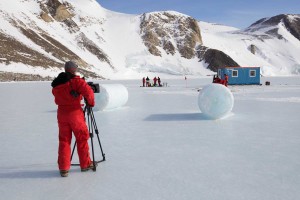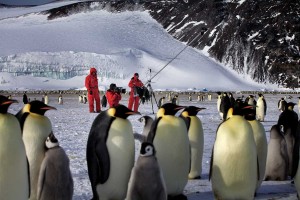
he spent a month at the South Pole – with merciless temperatures dropping to -50° C (58º F) – a real test for the crew and the equipment. He brought along an FSB 6/2 D tripod system by Sachtler.
“Transport over icy, snowy and rocky terrain is very difficult. That’s why the equipment has to be extremely robust and very lightweight at the same time,” Beltrame said. “The less weight, the better.” During shooting, temperatures between 40 to 50 °C below zero (-40 to -58 ºF) were the norm. Fortunately, the fluid heads of the Sachtler FSB series, with its metal casing, make the FSB 6 particularly resistant and robust. The damping mechanism, with three horizontal and three vertical grades of drag +0, remains unfazed by the extreme temperatures. Together with the ENG 75/2 D tripod, the fluid head weighs in at only 5.3 kg (11.7 lbs), which makes it easy to transport. With a transport length of 84 cm (33.1 in), the compact tripod system can be comfortably carried on the shoulder.

“I like the adventure and extreme productions,” he said. “Underwater, windy mountain tops and caves – these are my specialties.” Thanks to the sideload camera plate with the Snap & Go mechanism, camera configurations can be prepared according to climate and project requirements and then be set on the fluid head from the side with a turn of the hand – even if that hand is covered by a thick glove. During the Antarctic shoot, the extreme temperatures required frequent battery changes, which made it especially important that the counterbalance of the camera setup worked quickly and simply. Beltrame found support in the long, 120-mm sliding range of the camera plate and the 10-step counterbalance with Speedbalance technology for setups from 1.5 to 8 kg (3.3 to 17.6 lbs). With the step-shifting system, the settings can be reproduced exactly, and counterbalance is instantly achieved.
“The quality of pan and tilt movements is a basic requirement,” he said. “It doesn’t matter how well you prepare, you never know how much leeway you’ll actually have. That’s exactly why you need the best possible camera support. Especially when – as in the Antarctic – contact to the outside world is only possible every 15 days when a military airplane comes from New Zealand. The worst case scenario is that you have to do without a tripod system for more than two weeks.”





